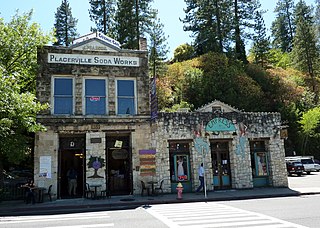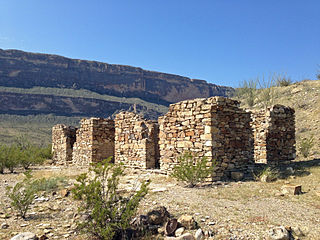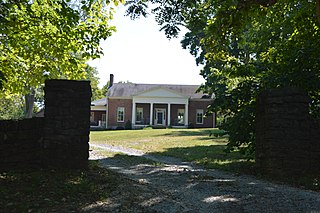Related Research Articles

Casa Grande Ruins National Monument, in Coolidge, Arizona, just north-east of the city of Casa Grande, preserves a group of Hohokam structures dating to the Classic Period (1150–1450 CE).

Waveland State Historic Site, also known as the Joseph Bryan House, in Lexington, Kentucky is the site of a Greek Revival home and 10 acres now maintained and operated as part of the Kentucky state park system. It was the home of the Joseph Bryan family, their descendants and the people they enslaved in the nineteenth century. Bryan's father William had befriended Daniel Boone and they migrated west through the Cumberland Gap.

Trinity Episcopal Church is located in Covington, Kentucky, Madison Avenue. This historic church was founded November 24, 1842, in a third floor of a brick building near the Covington market. The cornerstone of the first church was June 24, 1843 and the first service was on June 30, 1844. The church has served the people of Covington and Cincinnati, Ohio through wars and floods. The church is active today, with a large congregation at its Fourth and Madison Avenue location. The Rev. Peter D'Angio is the rector. It is the second largest parish in the Episcopal Diocese of Lexington.

The United States Marine Hospital in Louisville, Kentucky, in the Portland neighborhood was built in 1845, and is considered by the National Park Service to be the best remaining antebellum hospital in the United States.

Wendover, also known as Frontier Nursing Service or Big House, is a historic house and former medical care facility near Hyden, Kentucky. Built in 1925, it is notable for its association with the American effort to professionalize midwifery, led by Mary Breckinridge (1881-1965). It was headquarters of the Frontier Nursing Service, an organization which continues today. Wendover was named a U.S. National Historic Landmark in 1991 for this role. It now serves as a bed and breakfast inn and retreat operated by the Service's successor, Frontier Nursing University.

The historic Nelson County Jail in the Bardstown Historic District in Bardstown, Kentucky is a property on the National Register of Historic Places. It is next door to the Old Talbott Tavern.The property served as Nelson County, Kentucky's jail from 1797 to 1987. The old jail was originally built in 1819.

Cobblestone architecture refers to the use of cobblestones embedded in mortar as method for erecting walls on houses and commercial buildings. It was frequently used in the northeastern United States and upper Midwest in the early 19th century; the greatest concentration of surviving cobblestone buildings is in New York State, generally near the historic Erie Canal or connecting canals.

The John Pearson Soda Works, also referred to as the Placerville Soda Works, is a historic rustic vernacular Victorian brick building in Placerville, El Dorado County, California. The building, in the Gold Country region, was placed on the National Register of Historic Places (NRHP) on December 12, 1985. The building housed the Cozmic Café coffee shop and venue from 2003 until 2018.
The Joel Frazer House is a historic residence near Cynthiana, Kentucky, United States, that was built in 1810 by the stonemason and future Kentucky governor Thomas Metcalf. It was listed on the National Register of Historic Places in 1983. The house is on the north bank of the "Licking River" per its National Register nomination, which near Cynthiana would mean what is actually termed South Fork Licking River.

Rancho Estelle was the home of James Sublett, one of the first large-scale farmers in the Rio Grande valley of Texas, within what is now Big Bend National Park. Prior to founding the ranch, Sublett and his partner, Clyde Buttrill, farmed the bottomlands along the river in the area of what is now known as Castolon or La Harmonia, downstream from the later ranch. After the partnership with Buttrill broke up, Sublett bought four sections of land, initially calling it Grand Canyon Farms, and later Rancho Estelle.

The De Mores Packing Plant Ruins near Medora in Billings County, North Dakota, is a historic site listed on the National Register of Historic Places (NRHP). The site is now preserved as Chimney Park, the largest open space within Medora's city limits.

The Joel Dreibelbis Farm is an historic American farm complex and national historic district that are located in Richmond Township, Berks County, Pennsylvania.

Fort Apache Historic Park is a tribal historic park of the White Mountain Apache, located at the former site of Fort Apache on the Fort Apache Indian Reservation. The park interprets the rich and troubled history of relations between the Apache and other Native American tribes at the fort, which was converted into a Bureau of Indian Affairs boarding school after its military use ended. The park, which covers 288 acres (117 ha) of the former fort and school, as well as a nearby military cemetery, form the National Historic Landmark Fort Apache and Theodore Roosevelt School historic district.

The Frankfort Commercial Historic District in Frankfort, Kentucky is a 24 acres (9.7 ha) historic district which was listed on the National Register of Historic Places in 1979. It included 86 contributing buildings and one contributing structure.

The Owen-Gay Farm in Clark County and Bourbon County in Kentucky was listed on the National Register of Historic Places in 1997. The property included two contributing buildings, nine contributing structures and one contributing site, on 238 acres (96 ha).

The Adam Dunlap Farmstead, built by a Yankee settler family, was one of the first farms in the Town of Mazomanie, Wisconsin. A number of the original structures, built around 1849 from stone quarried on the farm, are still intact. The farmstead was added to the State and the National Register of Historic Places in 2003, for being a relatively intact homestead of a progressive Yankee pioneer settler, and for the Greek Revival style of the stone farmhouse.
The Big Sink Rural Historic District, in Woodford County, Kentucky near Versailles, Kentucky, is a 5,000 acres (20 km2) historic district which was listed on the National Register of Historic Places in 1994. The listing included Number of 180 contributing buildings, 33 contributing structures, and 44 contributing sites.
References
- ↑ "National Register Information System". National Register of Historic Places . National Park Service. January 23, 2007.
- ↑ NRHP Nomination Form-Early Stone Buildings of Kentucky, pg 7.14